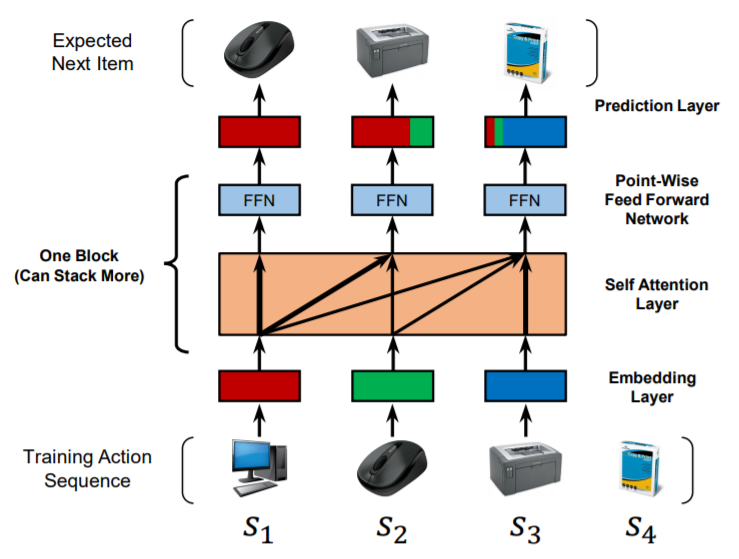SASRec¶
Introduction¶
Title: Self-Attentive Sequential Recommendation
Authors: Wang-Cheng Kang, Julian McAuley
Abstract: Sequential dynamics are a key feature of many modern recommender systems, which seek to capture the ‘context’ of users’ activities on the basis of actions they have performed recently. To capture such patterns, two approaches have proliferated: Markov Chains (MCs) and Recurrent Neural Networks (RNNs). Markov Chains assume that a user’s next action can be predicted on the basis of just their last (or last few) actions, while RNNs in principle allow for longer-term semantics to be uncovered. Generally speaking, MC-based methods perform best in extremely sparse datasets, where model parsimony is critical, while RNNs perform better in denser datasets where higher model complexity is affordable. The goal of our work is to balance these two goals, by proposing a self-attention based sequential model (SASRec) that allows us to capture long-term semantics (like an RNN), but, using an attention mechanism, makes its predictions based on relatively few actions (like an MC). At each time step, SASRec seeks to identify which items are ‘relevant’ from a user’s action history, and use them to predict the next item. Extensive empirical studies show that our method outperforms various state-of-the-art sequential models (including MC/CNN/RNN-based approaches) on both sparse and dense datasets. Moreover, the model is an order of magnitude more efficient than comparable CNN/RNN-based models. Visualizations on attention weights also show how our model adaptively handles datasets with various density, and uncovers meaningful patterns in activity sequences.

Running with RecBole¶
Model Hyper-Parameters:
hidden_size (int): The number of features in the hidden state. It is also the initial embedding size of item. Defaults to64.inner_size (int): The inner hidden size in feed-forward layer. Defaults to256.n_layers (int): The number of transformer layers in transformer encoder. Defaults to2.n_heads (int): The number of attention heads for multi-head attention layer. Defaults to2.hidden_dropout_prob (float): The probability of an element to be zeroed. Defaults to0.5.attn_dropout_prob (float): The probability of an attention score to be zeroed. Defaults to0.5.hidden_act (str): The activation function in feed-forward layer. Defaults to'gelu'. Range in['gelu', 'relu', 'swish', 'tanh', 'sigmoid'].layer_norm_eps (float): A value added to the denominator for numerical stability, Defaults to1e-12.initializer_range (float): The standard deviation for normal initialization. Defaults to 0.02``.loss_type (str): The type of loss function. If it set to'CE', the training task is regarded as a multi-classification task and the target item is the ground truth. In this way, negative sampling is not needed. If it set to'BPR', the training task will be optimized in the pair-wise way, which maximize the difference between positive item and negative item. In this way, negative sampling is necessary, such as setting--neg_sampling="{'uniform': 1}". Defaults to'CE'. Range in['BPR', 'CE'].
A Running Example:
Write the following code to a python file, such as run.py
from recbole.quick_start import run_recbole
parameter_dict = {
'neg_sampling': None,
}
run_recbole(model='SASRec', dataset='ml-100k', config_dict=parameter_dict)
And then:
python run.py
Tuning Hyper Parameters¶
If you want to use HyperTuning to tune hyper parameters of this model, you can copy the following settings and name it as hyper.test.
learning_rate choice [0.01,0.005,0.001,0.0005,0.0001]
attn_dropout_prob choice [0.2, 0.5]
hidden_dropout_prob choice [0.2, 0.5]
n_heads choice [1, 2]
n_layers choice [1,2,3]
Note that we just provide these hyper parameter ranges for reference only, and we can not guarantee that they are the optimal range of this model.
Then, with the source code of RecBole (you can download it from GitHub), you can run the run_hyper.py to tuning:
python run_hyper.py --model=[model_name] --dataset=[dataset_name] --config_files=[config_files_path] --params_file=hyper.test
For more details about Parameter Tuning, refer to Parameter Tuning.
If you want to change parameters, dataset or evaluation settings, take a look at